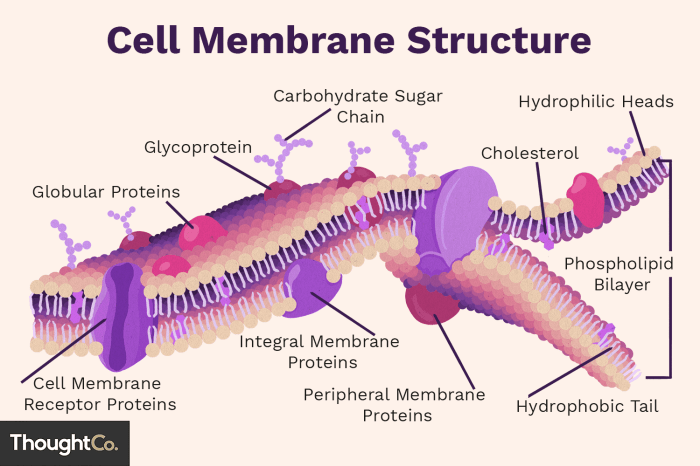The membrane that surrounds a certain type of living cell – The cell membrane, a vital structure that surrounds every living cell, plays a pivotal role in maintaining cellular integrity, regulating substance exchange, and facilitating communication. Its intricate composition and dynamic nature make it an essential component for cellular function and survival.
This article delves into the fascinating world of the cell membrane, exploring its structure, functions, and the diverse roles it plays in cellular processes. We will also examine common disorders associated with the cell membrane and the potential treatments available.
Cell Membrane Structure

The cell membrane, also known as the plasma membrane, is a thin layer that surrounds and encloses all living cells. It serves as a protective barrier, regulates the passage of substances into and out of the cell, and plays a crucial role in cell signaling and communication.
The cell membrane is composed of a phospholipid bilayer, which is a double layer of phospholipids arranged with their hydrophilic (water-loving) heads facing outward and their hydrophobic (water-hating) tails facing inward. This arrangement creates a selectively permeable barrier that allows certain substances to pass through while blocking others.
Embedded within the phospholipid bilayer are various proteins, including integral proteins that span the entire membrane and peripheral proteins that are loosely attached to the surface of the membrane. These proteins serve a variety of functions, including transporting molecules across the membrane, recognizing and binding to specific molecules, and transmitting signals from the outside to the inside of the cell.
The structure of the cell membrane is dynamic and constantly changing. The phospholipids and proteins are able to move laterally within the membrane, and the membrane can also undergo endocytosis and exocytosis, processes by which materials are taken into and released from the cell, respectively.
Cell Membrane Function
The cell membrane performs a wide range of functions that are essential for the survival and proper functioning of the cell.
- Protection:The cell membrane forms a protective barrier around the cell, protecting it from damage caused by mechanical stress, changes in temperature, and exposure to toxic substances.
- Regulation of substance movement:The cell membrane regulates the movement of substances into and out of the cell. This is achieved through a variety of mechanisms, including passive diffusion, facilitated diffusion, and active transport.
- Cell signaling and communication:The cell membrane contains receptors that bind to specific molecules, such as hormones and neurotransmitters, which trigger intracellular signaling pathways. This allows cells to communicate with each other and respond to changes in their environment.
Types of Cell Membranes

There are different types of cell membranes, each with its own unique structure and function.
- Plasma membrane:The plasma membrane is the outermost membrane of all cells. It is responsible for protecting the cell and regulating the movement of substances into and out of the cell.
- Nuclear membrane:The nuclear membrane surrounds the nucleus of eukaryotic cells. It regulates the movement of materials between the nucleus and the cytoplasm.
- Mitochondrial membrane:The mitochondrial membrane surrounds the mitochondria of eukaryotic cells. It regulates the movement of materials between the mitochondria and the cytoplasm.
- Chloroplast membrane:The chloroplast membrane surrounds the chloroplasts of plant cells. It regulates the movement of materials between the chloroplasts and the cytoplasm.
Cell Membrane Dynamics: The Membrane That Surrounds A Certain Type Of Living Cell
The cell membrane is not a static structure but rather a dynamic and constantly changing entity. The phospholipids and proteins that make up the membrane are able to move laterally within the membrane, and the membrane can also undergo endocytosis and exocytosis.
Membrane fluidity:The ability of the phospholipids and proteins to move laterally within the membrane is known as membrane fluidity. Membrane fluidity is essential for a variety of cellular processes, including cell movement, cell signaling, and the transport of materials across the membrane.
Membrane turnover:The cell membrane is constantly being remodeled through a process known as membrane turnover. In membrane turnover, new phospholipids and proteins are added to the membrane while old ones are removed. Membrane turnover is essential for maintaining the integrity and function of the cell membrane.
Cell Membrane Disorders

A number of disorders can affect the cell membrane, leading to a variety of health problems.
- Cystic fibrosis:Cystic fibrosis is a genetic disorder that affects the cell membrane of epithelial cells. The defective cell membrane leads to the accumulation of thick mucus in the lungs and other organs, which can cause breathing difficulties and other health problems.
- Sickle cell anemia:Sickle cell anemia is a genetic disorder that affects the cell membrane of red blood cells. The defective cell membrane causes the red blood cells to become sickle-shaped, which can lead to blockages in blood vessels and a variety of health problems.
- Tay-Sachs disease:Tay-Sachs disease is a genetic disorder that affects the cell membrane of nerve cells. The defective cell membrane leads to the accumulation of a fatty substance in the nerve cells, which can cause progressive neurological damage and death.
FAQ Section
What is the primary function of the cell membrane?
The cell membrane’s primary function is to serve as a selective barrier, regulating the movement of substances into and out of the cell while maintaining its internal environment.
How does the cell membrane contribute to cell signaling?
The cell membrane contains receptors that bind to specific signaling molecules, triggering intracellular responses and facilitating communication between cells.
What are some common cell membrane disorders?
Common cell membrane disorders include cystic fibrosis, sickle cell anemia, and Tay-Sachs disease, which result from mutations in genes encoding membrane proteins.